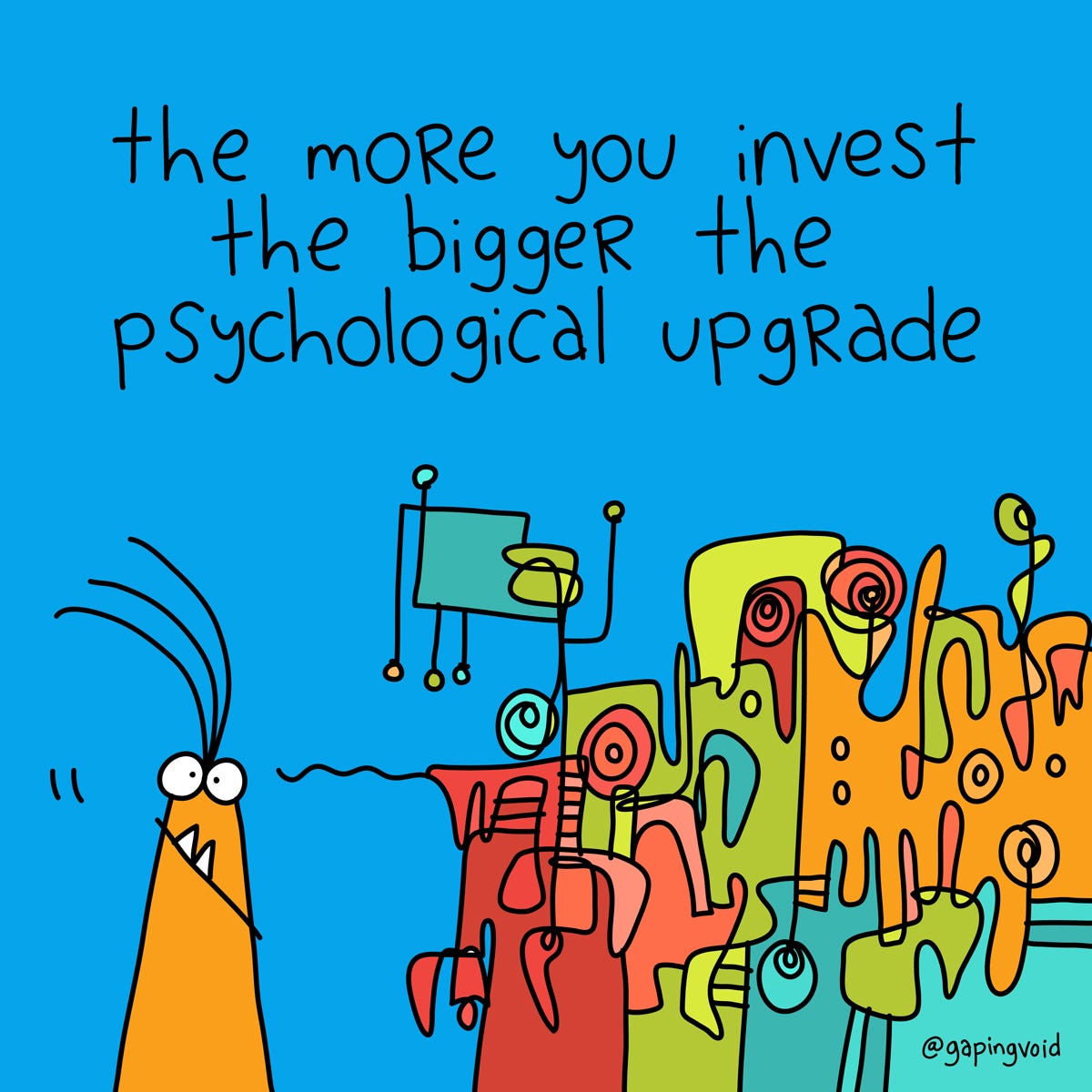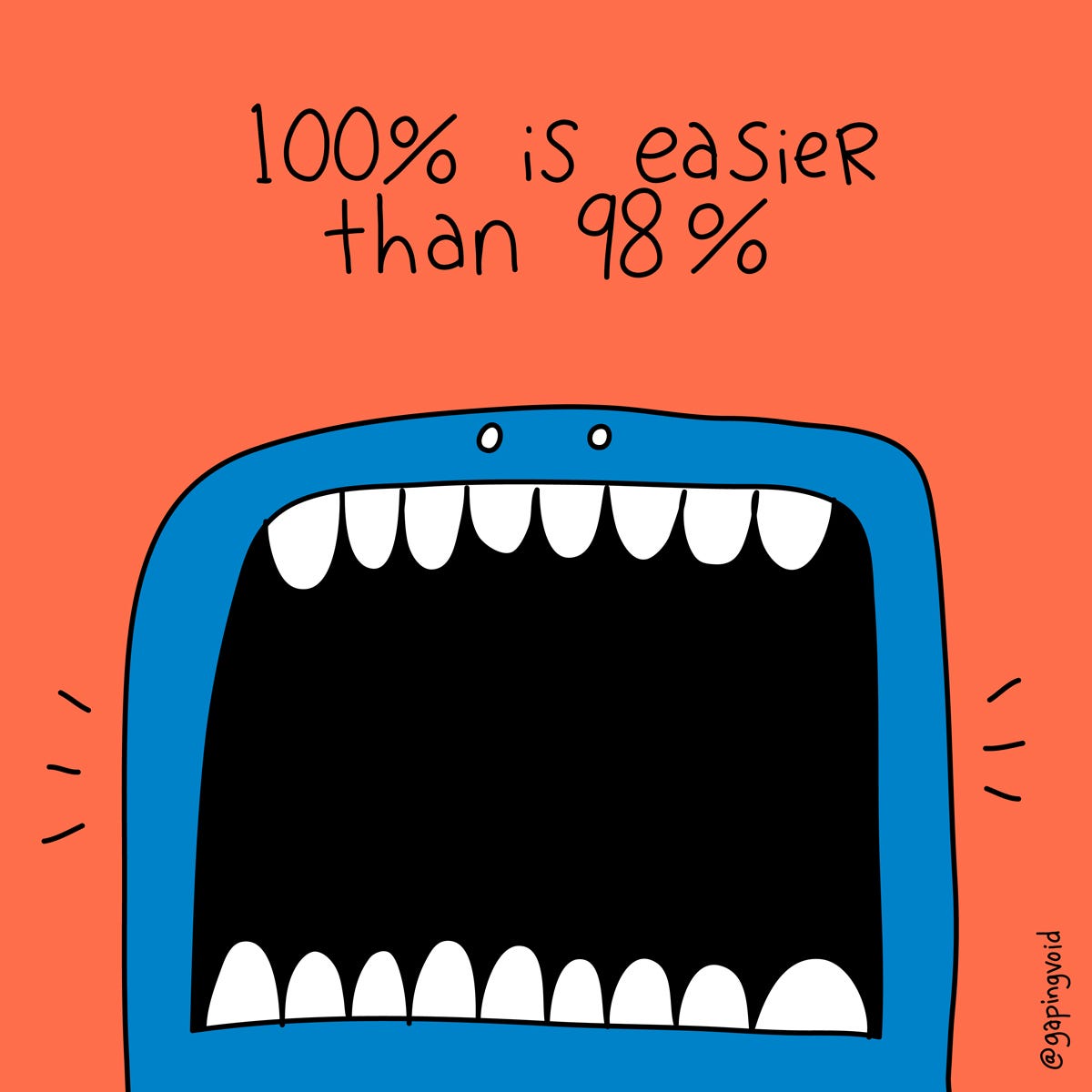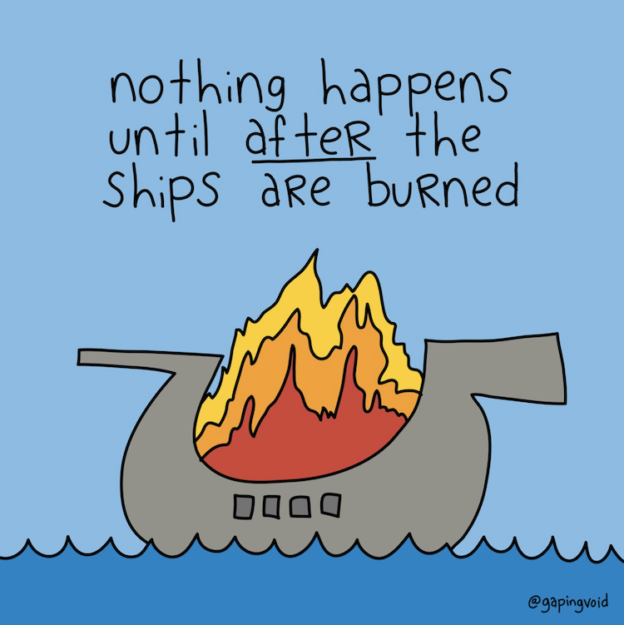“Nothing can resist a human will that will stake its existence on a purpose.” — Benjamin Disraeli
There’s a shift that must happen within. Something clicks-in and your brain and biology can never go back.
Ralph Waldo Emerson said, “The mind, once stretched by a new idea, never returns to its original dimensions.”
Ideas can only truly catch hold if they are embedded within a deeply emotional experience that reshapes how you view your identity and purpose in life.
When an idea becomes your obsession and purpose — and it is highly personal to you — then you can take that idea and quickly turn it into a reality.
You don’t need to be defined by the norms and expectations of those around you. You don’t even have to play the same game as everyone else. You’re living in your own world and creating at will, whatever it is you want to see.
Jim Rohn said, “Sometimes all you need to open the door is just one more good idea.”
You need an idea that shakes-you-up and stirs deep imagination. An idea that moves, inspires, and motivates you.
You need a splendid idea that actually embarrasses you, one in which you don’t want to share with others because you know they won’t understand.
Are You Embarrassed By Your Goals? If Not, You’re Losing
If what you’re pursuing right now isn’t so big that you’d be embarrassed to share it with most of the people in your life, I challenge you to take a step back and really think about it.
Why would you play small?
Why pursue something that is seemingly logical to achieve?
Why pursue something that doesn’t require innovation and a redesign of the current system to have?
Buckminster Fuller said, “You never change things by fighting against the existing reality. To change something, build a new model that makes the old model obsolete.”
The traditional approach to life needs to be up-ended and replaced with something totally new.
When you replace your mental and emotional system with new ideas and new experiences, you literally can’t go back. The old system in which you were operating becomes obsolete. It actually vanishes and can no longer be re-accessed.
You can’t go back when you’ve had certain experiences and when certain ideas take hold.
The remainder of this article will break-down the process of reaching this personal point of no return — where your mind get stretched and can’t go back.
This is how you live your life on purpose. This is how you evolve by choice and how you go to the next level, over and over.
You reach your major goals and start getting bored.
“There are two tragedies in life: One is not getting your heart’s desire; The other is to get it.” — George Bernard Shaw
Whether you’re currently winning or losing in life — you will quickly adapt to your circumstances.
Human beings are highly adaptive. We can get bored very easily without having new things to pursue. The brain needs novelty to thrive, otherwise it quickly becomes stale. A sharp mind can dull quickly.
The worst thing you can do is try to keep things how they are. Growth requires offense — or what psychologists call an “approach-orientation” where you focus more on the rewards of a new future than the potential risks.
The worst thing you could do is have what psychologists call an “avoid-orientation,” where you focus most of your energy and thought on maintaining your current position or protecting your current status. You must advance, otherwise you’re going backwards.
You detach yourself from your prior success and status.
“I can’t go back to yesterday — because I was a different person then.” — Lewis Carroll
The only way to get to the next level is by letting go of who you’ve been. The longer you hold on, the smaller your thinking will be.
This is approach-oriented psychology. Don’t get stuck where you were. Be willing to banish the past — no matter how great — for a better future.
The mind and brain seek expansion and growth far more than stability and certainty. We are programmed and designed to solve complex situations and turn chaos into system.
If you’re not willing to embrace the chaos of rapid growth and change, then you’ll age physically and deteriorate mentally. Every time you step into growth, you’ll experience an increase in complexity and chaos. Growth is the process of taking something that was once complex and making it simple, systemized, and subconscious.
This is how you slow down time. This is how you grow. You step into chaos and create simplicity and knowingness. You can get to the point where you can handle chaos that most people would never dream of — because you know you can deal with it, learn it, and own it.
You start seeking lots of information to clarify your new vision.
“Kids should be allowed to break stuff more often. That’s a consequence of exploration. Exploration is what you do when you don’t know what you’re doing. That’s what scientists do every day.” — Neil deGrasse Tyson
Exploration and searching are key to discovering what is possible and what is out there. You don’t know what you don’t know.
You must be exposed to new universes to realize it’s possible to expand far beyond the current sphere in which you’ve found yourself.
How can you parlay what you’ve done and laterally-jump into a new world with new growth and bigger possibilities?
In the book, Smartcuts: How Hackers, Innovators, and Icons Accelerate Success,journalist Shane Snow explains that most of the United States Presidents spent less time in politics than the average congressman. Moreover, the best, and most popular Presidents, generally spent the least amount of time in politics. Rather than spending decades climbing the tedious ladder with glass ceilings, they simply jumped laterally from a different, non-political ladder.
As Snow distills, “Lateral thinking doesn’t replace hard work; it eliminates unnecessary cycles.”
You start looking at new role models to learn from and surpass.
“Wanna be a bodybuilder? Compare yourself to Arnold. Wanna be an actor? Compare yourself to DiCaprio. Wanna be a musician? Compare yourself to Rehman. Wanna be a dancer? Compare yourself to Michael Jackson. Wanna make money?compare yourself to Musk. Wanna be a writer? Compare yourself to Shakespeare. Wanna make the world a better place? Compare yourself to the Mother Teresa.” — Dwija
As you begin developing new perspectives and possibilities, use your pattern recognition to develop taste. What is working in this new sphere and what is not working?
What is working extremely well?
There’s a lot of talk about how comparing yourself to others is a bad thing. It’s not. Trying to be someone else, however, is a very bad thing. Mimicry can quickly become idol-worship.
But being inspired by someone and learning from their mastery is not only a good thing, it’s essential to learning and growth.
Why not fast-track your process by holding your own to the same standards as those in the top of the industry? Actually, study the best so much and understand why it works so you can quickly innovate and evolve beyond it.
Don’t be an imitator. Be an innovator. In the book, The Lessons of History, Will and Ariel Durant explain that throughout history, most people lack the creativity and courage to innovate. They prefer to imitate what has worked, and thus never create anything original.
This makes absolute sense. Innovation requires a deep learning and sense of context — and a willingness to pursue ideas beyond that context which might not work. As Sir Ken Robinson in his important TED Talk, “If you’re not prepared to be wrong, you’ll never come up with anything original.”
Dan Sullivan explains that certain people are “Game Changers.” These people are industry transformers who don’t just work in a certain industry, they continually disrupt it.
If you’re not changing the game, then you’re playing someone else’s game. To repeat Buckminster Fuller: “You never change things by fighting against the existing reality. To change something, build a new model that makes the old model obsolete.”
When was the last time you innovated and disrupted an entire industry?
When was the last time you innovated and disrupted your own life?
You begin to conceptualize your new ‘why.’
“Nothing can resist a human will that will stake its existence on a purpose.” — Benjamin Disraeli
As you begin to see benchmarks of what is possible in the form of various role-models from multiple domains, you begin to crystallize and clarify your personal WHY.
You’ll be able to have concrete concepts to point to in explaining what matters to you, where you’re going, and how you’re going to do it.
You go through long and deep periods of contemplation.
“To discern what is truly essential we need space to think, time to look and listen, permission to play, wisdom to sleep, and the discipline to apply highly selective criteria to the choices we make.” — Greg McKeown
As your crystallizing your WHY — and future goals and plans — you’ll be spending lots of time by yourself. You’ll be out in your own personal desert really connecting and preparing yourself for the next Everest you’re about to climb.
You’ve already mentally and emotionally disconnected from your past outcomes and identity. You’ve already emotionally-connected to your new WHY and dreams. But you just need to settle it at the biological-level, where your body and brain are prepared and expect what’s about to happen next.
You make micro-commitments to force yourself forward.
“A forcing function is any task, activity or event that forces you to take action and produce a result.” — Dan Martell
You then begin turning your vision into a reality as quickly as possible.
You begin telling people what’s next. You begin making changes to your environment and relationships that reflect the old you and old vision.
Your environment, language, behavior, and life begin to quickly reshape themselves to match the new reality you’ve spiritually and emotionally created.
You begin making investments in the new and bigger vision.
“Invest in yourself. You can afford it. Trust me.” — Rashon Carraway

You create a point of no return and solidify the new vision through financial investment. There’s no looking back. There’s no going back.
You couldn’t go back mentally if you wanted to. But now you’re positioning your life for the next big climb. You’ve just increased your emotional-commitment 10-fold by putting big pieces in place.
According to former Shark Tank Shark, Kevin Harrington, “Exponential thinkers do not hire who they can afford. They hire who can get the job done.”
The question is, how big are you willing to play?
Eben Pagan has a concept he calls “Inevitability Thinking,” which he defines as “Thinking and acting as if what you are doing is a forgone conclusion because you set up the conditions for it to happen.”
Are you willing to set up conditions that make success inevitable?
Are you ready to get hyper approach-oriented, where you focus on rewards over risks?
You have a new end-point that excites and inspires you.
“There are only three requirements for success. First, decide exactly what it is you want in life. Second, determine the price that you are going to have to pay to get the things you want. And third, and this is most important, resolve to pay that price.” — H.L. Hunt, billionaire
The focus on risks over rewards isn’t just a fun idea that entrepreneurs throw around. It’s actually the basis of one of the most studied theories of motivation in psychology, known as Expectancy Theory.
According to the theory, three things must be in place for a person to have extreme and uncommon levels of motivation:
- You must believe the reward (the ‘WHY’) of a particular goal is important, meaningful, and compelling.
- You must believe that you know how (clear strategies/plans/people) to achieve your goal.
- You must believe that you can execute the plans, strategies, and pivoting involved in achieving the goal.
The rewards you seek must be deeply motivating and personally fulfilling. They have to mean something to you on a cosmic and existential level. They have to connect with your deepest identity and belief system about the purpose of your existence.
You must want it so badly that you have what psychologists call “pull motivation,” which is where you cannot stop pursuing what you’re after. The philosopher Rumi says it best: “What you seek is seeking you.”
You cannot compete with people who have this level of purpose. Willpower cannot compete with WHY-power. Don’t even try.
You begin surrounding yourself with people way beyond where you currently are.
“Don’t join an easy crowd; you won’t grow. Go where the expectations and the demands to perform are high.” — Jim Rohn
You begin doing work that matches the future vision you seek to create. It’s at a different level than has been seen before. Quickly, you learn to surround yourself with people who are operating at quantum levels above what you’ve been conditioned.
You quickly adapt to their systems of thought and emotion. Your new normal has fundamentally changed, as has the fiber of your being. Your new environment demands that you continue playing at the level you seek.
Life continually becomes more and more of a game and less of a grind. The rules are increasingly tilted in your favor because you are designing them.
You take the leap and never look back.
“There is a point at which everything becomes simple and there is no longer any question of choice, because all you have staked will be lost if you look back. Life’s point of no return.” — Dag Hammarskjold

Have you taken the leap?
Have you crossed your point of no return?
Is your mind stretched by new experiences and new ideas?
Ready to Upgrade?
I’ve created a cheat sheet for putting yourself into a PEAK-STATE, immediately. You follow this daily, your life will change quickly.








